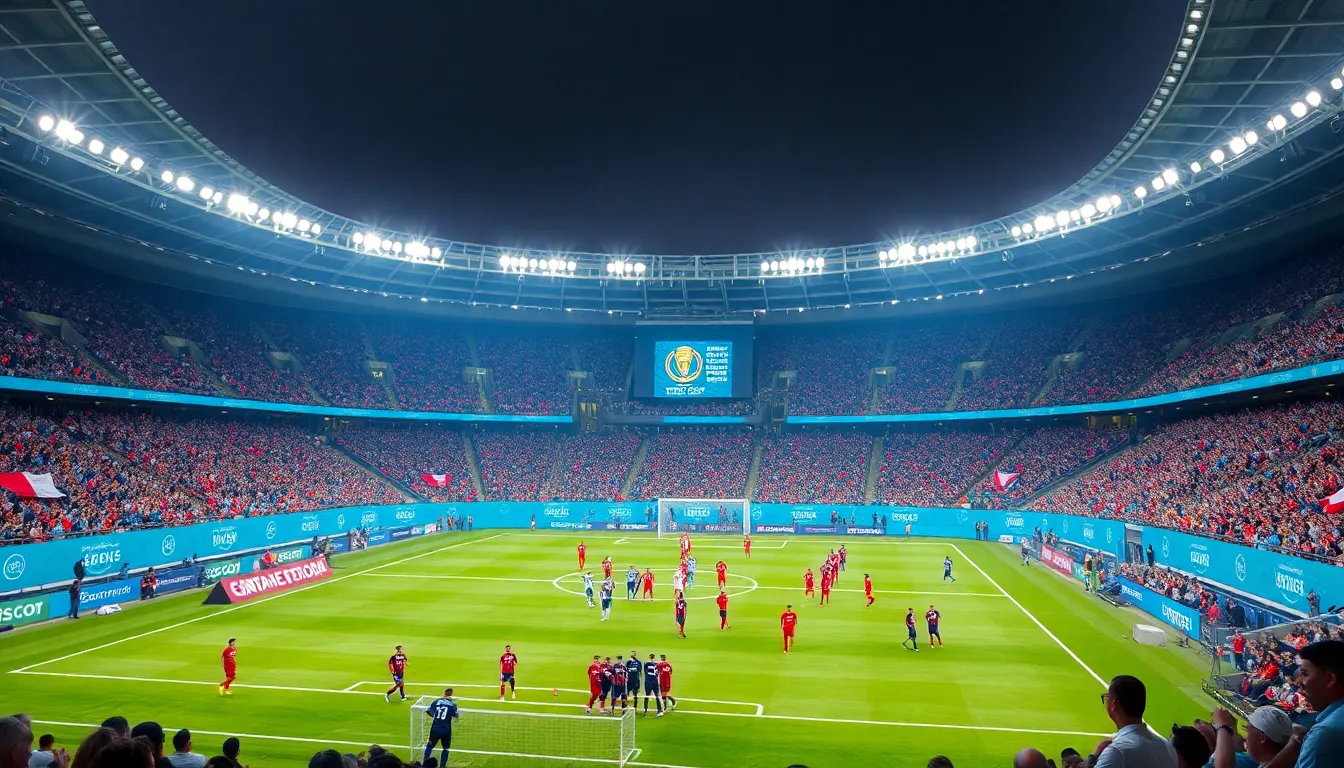Picture this: the world’s best football clubs battling it out for ultimate bragging rights, all while fans cheer, jeer, and maybe even throw a few snacks in excitement. Welcome to the FIFA Club World Cup, where the elite of the elite come together to prove who’s truly king of the pitch. It’s like the Olympics of club football, but with fewer sports and a lot more drama.
Table of Contents
ToggleOverview of FIFA Club World Cup
The FIFA Club World Cup features the champions from six continental confederations and the host nation’s league winner. This prestigious tournament showcases the best clubs in football, creating a platform for global competition.
Competition takes place annually, with the event typically held in December. Each edition offers thrilling matches, highlighting the talent and skills of elite players. Football clubs such as Real Madrid, Barcelona, and Bayern Munich have dominated past tournaments, reflecting their status in world football.
Matches occur over a concise period, usually lasting around two weeks. The format includes a total of seven teams, competing in a knockout system. The tournament provides the winning team with a significant accolade, often enhancing their global reputation.
Clubs gain an opportunity to elevate their international profile by participating in the FIFA Club World Cup. Sponsorship deals and broadcasting rights expand significantly for teams involved, bringing financial benefits.
Fans engage passionately with the tournament, intensifying the atmosphere at stadiums around the world. The event not only determines the world’s best club but also fosters connections among supporters across different cultures.
In recent years, the World Cup has faced challenges from growing rival competitions. Discussion about the future format and frequency of the tournament continues, reflecting its evolving nature in the world of football. The commitment to tradition remains strong, ensuring the FIFA Club World Cup retains its significance on the football calendar.
History of FIFA Club World Cup

The FIFA Club World Cup has a rich history that highlights the evolution of club football on a global stage. This tournament began in 2000, originally designed to replace the Intercontinental Cup, showcasing the champions from various continents.
Inception and Early Years
In 2000, the inaugural tournament took place in Brazil, featuring champions such as Corinthians and Manchester United. A brief hiatus occurred due to organizational issues, but the event returned in 2005, solidifying its place in the football calendar. Each of the six continental champions plus the host nation’s league winner brought a competitive edge, drawing attention from fans worldwide. Early editions often showcased dominant performances, with clubs like São Paulo and Liverpool winning titles in the first few years. The excitement helped establish the tournament as a premier event for club teams.
Recent Developments
Recent editions of the FIFA Club World Cup illustrate the tournament’s ongoing evolution since 2019. Over the years, clubs from Europe frequently dominated, with Real Madrid securing four titles, bolstering its global brand. Amid emerging rivalries, FIFA announced a revamped format starting in 2025, intending to expand the tournament to 32 teams and increase participation from diverse leagues. This change aims to enhance competitiveness while maintaining significant global interest. As the tournament faces challenges, its commitment to showcasing top football clubs remains resolute in the dynamic landscape of international football.
Format and Structure of the Tournament
The FIFA Club World Cup features a unique structure aimed at showcasing the best clubs globally. This tournament brings together top teams, ensuring thrilling matches and intense competition.
Participating Teams
Seven clubs participate in the tournament. Each year, it includes the champions from six continental confederations: UEFA, CONMEBOL, CONCACAF, CAF, AFC, and OFC, along with the league winner from the host nation. This format highlights diversity by presenting different football styles from various regions. Clubs can secure their spots through winning continental tournaments, reinforcing their status among the elite. Historically, teams like Real Madrid, Barcelona, and Bayern Munich represent Europe, while clubs like Palmeiras and Flamengo showcase South American talent.
Match Format and Scheduling
The tournament adopts a knockout format, with matches spanning a concise two-week period. It kicks off with a first-round match involving the representative from the host nation and one of the continental champions. Following this, the remaining teams enter in the quarterfinals. Semifinal matches determine the finalists, culminating in one last match to crown the champion. Scheduling typically occurs in December, aligning with the global football calendar. This timing allows clubs to compete for prestigious silverware while maintaining momentum in their domestic leagues.
Key Players and Teams to Watch
The FIFA Club World Cup features exceptional talent and legendary clubs. Fans keep a close eye on specific players and teams during the tournament.
Star Players
Football fans anticipate witnessing skills from top players. Lionel Messi stands out as a key figure, constantly delivering breathtaking performances. His experience and playmaking abilities often create pivotal moments for his team. Neymar, another remarkable player, dazzles audiences with his creativity and speed on the pitch. Additionally, players like Robert Lewandowski and Mohamed Salah showcase their scoring prowess, raising excitement levels. These star players consistently impact matches, making them vital parts of their clubs’ aspirations for success in the tournament.
Notable Clubs
Several clubs capture fans’ attention during the FIFA Club World Cup. Real Madrid, with its rich history, often emerges as a strong contender. They boast multiple titles, showcasing their dominance in the tournament. Barcelona, equally prestigious, boasts a legacy of attracting top talent and winning silverware. Clubs like Bayern Munich also remain in the spotlight, renowned for their tactical prowess and efficient gameplay. Other notable teams include Flamengo and Al Ahly, representing their respective continents with pride. Their participation adds excitement, often challenging the European giants in thrilling encounters.
Memorable Matches and Highlights
The FIFA Club World Cup features iconic matches that leave a lasting impression on fans. Historic moments define the tournament, showcasing the competitiveness at the heart of club football.
Historic Finals
Memorable finals reflect the essence of this tournament. The 2014 final saw Real Madrid triumph over San Lorenzo, solidifying their status with a 2-0 victory. A defining match occurred in 2016, when Real Madrid edged Club América 4-2 in a dramatic penalty shootout. Liverpool claimed their place in history by defeating Flamengo 1-0 in 2019, marking a significant achievement for the English club. These finals display not just skill but also moments of intense pressure, showcasing the thrill of the match atmosphere.
Upsets and Underdogs
Surprising outcomes often occur, with underdogs challenging established teams. In 2012, Corinthians surprised Chelsea, winning 1-0 to capture their first title in the competition. Al Ahly, the Egyptian powerhouse, reached the semifinals in 2020, demonstrating the growing potential of clubs outside Europe. These moments emphasize the unpredictable nature of football, as lower-seeded teams create unforgettable narratives. Fans cherish such upsets, highlighting the thrill of watching underdogs succeed against all odds.
The FIFA Club World Cup stands as a testament to the passion and excitement of club football on a global scale. With its unique format and diverse representation from various continents, it captures the essence of competition and camaraderie among fans. As the tournament evolves with plans for expansion in 2025, it promises to maintain its prestige while adapting to the changing landscape of football. The thrilling matches and iconic moments will continue to resonate with supporters, ensuring that the FIFA Club World Cup remains a highlight in the football calendar for years to come.



